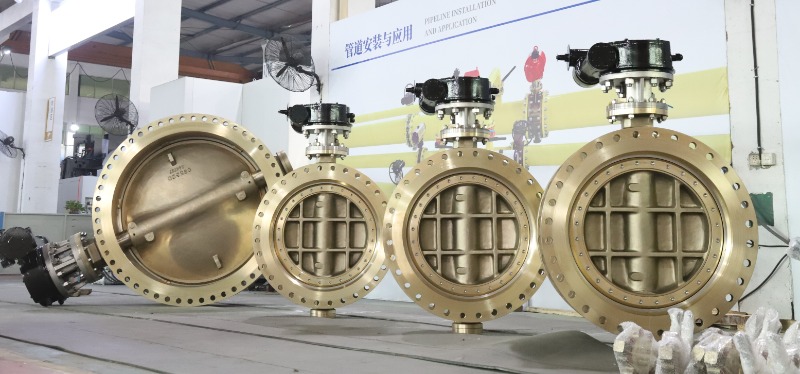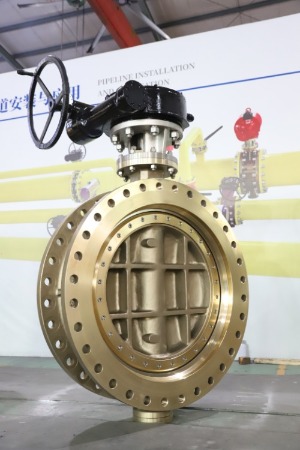In a major copper-gold mining project in Indonesia, DERVOS supplied multiple high-performance triple offset metal seated C95500 butterfly valves, which were applied in slurry transportation and process pipeline systems. The operating conditions on site are highly challenging, with media containing a large number of solid particles, posing significant risks of abrasion and corrosion. The valves were required to offer excellent wear resistance, corrosion resistance, and bidirectional zero leakage sealing performance.
As a professional triple offset butterfly valve supplier, DERVOS VALVE provided a customized solution tailored to the client’s specific needs, ensuring stable system operation even in such harsh environments.

Client Need
In a large-scale copper-gold mining project in Indonesia, DERVOS supplied multiple high-performance C95500 triple offset metal seated butterfly valves, specifically engineered for slurry transportation and process pipeline systems. The site presented extremely demanding conditions, with media containing high concentrations of solid particles—posing serious challenges related to abrasion and corrosion. To meet these requirements, the valves were designed to deliver exceptional wear resistance, corrosion resistance, and bidirectional zero-leakage sealing performance.
As a trusted triple offset butterfly valve manufacturer, DERVOS VALVE delivered a customized valve solution precisely tailored to the client's operational needs, ensuring long-term reliability and stable system performance under harsh industrial environments.
Devos Solution
DERVOS custom-engineered triple offset nickel-aluminum bronze metal seated butterfly valves for this project, featuring C95500 nickel-aluminum bronze valve bodies and F53+STL hard-faced welded seats, specifically designed for highly corrosive and abrasive environments.
Triple Offset Butterfly Valve – DN900/DN1500, 150LB, FF, API 609 Standard
• Size: DN900
• Pressure Rating: 150LB
• Design Features: Triple offset structure with bidirectional, zero-leakage
• sealing under equal pressure.
• Equipped with independent seat material: F53 + STL hard-facing. Operated via gear box.
Connection Type: FF (Flat Face) dual flange ends.
• Special Requirements:
Face-to-face dimension per ISO 5752 (short pattern)
Heat-treated and annealed castings
Excellent Wear and Corrosion Resistance
The valve body is made of C95500 nickel-aluminum bronze, known for its high strength, hardness, and outstanding wear resistance. It also offers excellent resistance to cavitation erosion and flow-induced corrosion.
In addition, C95500 exhibits good ductility and toughness—maintaining high mechanical strength while providing a certain degree of plasticity and impact resistance, which helps prevent brittle failure.
It demonstrates superior corrosion resistance in harsh media such as slurry, brine, and sulfide-rich environments.
The F53 + STL hard-faced welded sealing structure significantly enhances the sealing surface’s resistance to erosion and abrasion, ensuring long-term performance in demanding applications.
Bidirectional Zero-Leakage Sealing Design
The triple offset design, combined with equal-pressure sealing principles, effectively prevents bidirectional media leakage and meets the stringent safety control requirements of copper-gold mining operations.
High Reliability and Installation Adaptability
Designed according to the ISO 5752 short pattern standard, the valve structure allows for easy installation in confined spaces while minimizing installation stress.
The robust gear-operated mechanism is highly durable and well-suited for the demanding operational conditions typically found in mining environments.
Customized Solutions to Support Project Success
In response to specific client requirements, the castings underwent annealing and tempering heat treatment to improve overall resistance to stress corrosion and ensure structural stability.
Backed by DERVOS’s comprehensive and strict quality control process, each butterfly valve is guaranteed to withstand the challenges of real-world site conditions.
Project Results and Operational Performance
All supplied butterfly valves successfully passed high differential pressure and solid-particle media testing, fully meeting bidirectional sealing performance standards.
The short-pattern butterfly valve design perfectly matched the client's pipeline layout, ensuring a smooth and efficient installation process.
The valves have been in service for over six months without any leakage or sealing issues. The client has expressed high recognition of their excellent wear and corrosion resistance in continuous operation.
DERVOS Core Competitiveness
DERVOS specializes in the customized development of triple offset butterfly valves, committed to delivering high-reliability valve solutions for complex working conditions worldwide. We focus on demanding applications involving high pressure, heavy wear, and strong corrosion, and possess extensive expertise in engineering solutions and material selection.
Our capabilities include the application of advanced materials such as C95500, C95800, 5A/6A duplex stainless steel, CF8, CF8M stainless steel, nickel-based alloys, Monel, and F53 super duplex.
DERVOS valves are fully compliant with international standards including API 609, ISO 5752, and EN 593, enabling us to provide globally recognized professional services and technical support.
If you are interested in our products and want to know more details,please leave a message here,we will reply you as soon as we can.